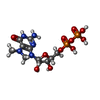+ Open data
Open data
- Basic information
Basic information
| Entry | Database: PDB / ID: 1ejh | |||||||||
|---|---|---|---|---|---|---|---|---|---|---|
| Title | EIF4E/EIF4G PEPTIDE/7-METHYL-GDP | |||||||||
 Components Components |
| |||||||||
 Keywords Keywords | TRANSLATION / eIF4E/eIF4GII peptide/7-methyl-GDP | |||||||||
| Function / homology |  Function and homology information Function and homology informationActivation of the mRNA upon binding of the cap-binding complex and eIFs, and subsequent binding to 43S / Transport of the SLBP independent Mature mRNA / Transport of the SLBP Dependant Mature mRNA / Transport of Mature mRNA Derived from an Intronless Transcript / Deadenylation of mRNA / ISG15 antiviral mechanism / Translation initiation complex formation / Ribosomal scanning and start codon recognition / L13a-mediated translational silencing of Ceruloplasmin expression / mTORC1-mediated signalling ...Activation of the mRNA upon binding of the cap-binding complex and eIFs, and subsequent binding to 43S / Transport of the SLBP independent Mature mRNA / Transport of the SLBP Dependant Mature mRNA / Transport of Mature mRNA Derived from an Intronless Transcript / Deadenylation of mRNA / ISG15 antiviral mechanism / Translation initiation complex formation / Ribosomal scanning and start codon recognition / L13a-mediated translational silencing of Ceruloplasmin expression / mTORC1-mediated signalling / GTP hydrolysis and joining of the 60S ribosomal subunit / eukaryotic initiation factor 4G binding / Activation of the mRNA upon binding of the cap-binding complex and eIFs, and subsequent binding to 43S / eukaryotic initiation factor 4E binding / regulation of translation at postsynapse, modulating synaptic transmission / eukaryotic translation initiation factor 4F complex / chromatoid body / mRNA cap binding / RNA 7-methylguanosine cap binding / RISC complex / nuclear export / stem cell population maintenance / negative regulation of neuron differentiation / TOR signaling / mTORC1-mediated signalling / cellular response to dexamethasone stimulus / behavioral fear response / mRNA export from nucleus / translation initiation factor binding / translation repressor activity / translation initiation factor activity / negative regulation of translational initiation / positive regulation of mitotic cell cycle / translational initiation / P-body / G1/S transition of mitotic cell cycle / neuron differentiation / cytoplasmic stress granule / regulation of translation / DNA-binding transcription factor binding / postsynapse / negative regulation of translation / nuclear speck / nuclear body / translation / perinuclear region of cytoplasm / glutamatergic synapse / enzyme binding / nucleus / cytoplasm / cytosol Similarity search - Function | |||||||||
| Biological species |  | |||||||||
| Method |  X-RAY DIFFRACTION / X-RAY DIFFRACTION /  SYNCHROTRON / Resolution: 2.2 Å SYNCHROTRON / Resolution: 2.2 Å | |||||||||
 Authors Authors | Marcotrigiano, J. / Gingras, A.-C. / Sonenberg, N. / Burley, S.K. | |||||||||
 Citation Citation |  Journal: Mol.Cell / Year: 1999 Journal: Mol.Cell / Year: 1999Title: Cap-dependent translation initiation in eukaryotes is regulated by a molecular mimic of eIF4G. Authors: Marcotrigiano, J. / Gingras, A.C. / Sonenberg, N. / Burley, S.K. | |||||||||
| History |
|
- Structure visualization
Structure visualization
| Structure viewer | Molecule:  Molmil Molmil Jmol/JSmol Jmol/JSmol |
|---|
- Downloads & links
Downloads & links
- Download
Download
| PDBx/mmCIF format |  1ejh.cif.gz 1ejh.cif.gz | 167.5 KB | Display |  PDBx/mmCIF format PDBx/mmCIF format |
|---|---|---|---|---|
| PDB format |  pdb1ejh.ent.gz pdb1ejh.ent.gz | 133.3 KB | Display |  PDB format PDB format |
| PDBx/mmJSON format |  1ejh.json.gz 1ejh.json.gz | Tree view |  PDBx/mmJSON format PDBx/mmJSON format | |
| Others |  Other downloads Other downloads |
-Validation report
| Summary document |  1ejh_validation.pdf.gz 1ejh_validation.pdf.gz | 1.5 MB | Display |  wwPDB validaton report wwPDB validaton report |
|---|---|---|---|---|
| Full document |  1ejh_full_validation.pdf.gz 1ejh_full_validation.pdf.gz | 1.6 MB | Display | |
| Data in XML |  1ejh_validation.xml.gz 1ejh_validation.xml.gz | 33 KB | Display | |
| Data in CIF |  1ejh_validation.cif.gz 1ejh_validation.cif.gz | 43.4 KB | Display | |
| Arichive directory |  https://data.pdbj.org/pub/pdb/validation_reports/ej/1ejh https://data.pdbj.org/pub/pdb/validation_reports/ej/1ejh ftp://data.pdbj.org/pub/pdb/validation_reports/ej/1ejh ftp://data.pdbj.org/pub/pdb/validation_reports/ej/1ejh | HTTPS FTP |
-Related structure data
- Links
Links
- Assembly
Assembly
| Deposited unit | 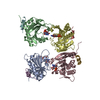
| ||||||||
|---|---|---|---|---|---|---|---|---|---|
| 1 | 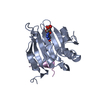
| ||||||||
| 2 | 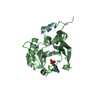
| ||||||||
| 3 | 
| ||||||||
| 4 | 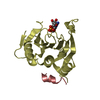
| ||||||||
| Unit cell |
|
- Components
Components
| #1: Protein | Mass: 22145.113 Da / Num. of mol.: 4 / Fragment: 28-217 Source method: isolated from a genetically manipulated source Source: (gene. exp.)   #2: Protein/peptide | Mass: 2050.335 Da / Num. of mol.: 4 / Fragment: 622-637 / Source method: obtained synthetically Details: THIS PEPTIDE WAS CHEMICALLY SYNTHESIZED. THE SEQUENCE OF THIS PEPTIDE NATURALLY OCCURS IN HUMANS (HOMO SAPIENS) References: GenBank: 2895097, UniProt: Q13541*PLUS #3: Chemical | ChemComp-M7G / #4: Water | ChemComp-HOH / | |
|---|
-Experimental details
-Experiment
| Experiment | Method:  X-RAY DIFFRACTION / Number of used crystals: 1 X-RAY DIFFRACTION / Number of used crystals: 1 |
|---|
- Sample preparation
Sample preparation
| Crystal | Density Matthews: 2.32 Å3/Da / Density % sol: 47.04 % | |||||||||||||||||||||||||
|---|---|---|---|---|---|---|---|---|---|---|---|---|---|---|---|---|---|---|---|---|---|---|---|---|---|---|
| Crystal grow | Temperature: 277 K / Method: vapor diffusion, hanging drop / pH: 8.5 Details: (NH4)2SO4 and Peg400, pH 8.5, VAPOR DIFFUSION, HANGING DROP | |||||||||||||||||||||||||
| Crystal grow | *PLUS | |||||||||||||||||||||||||
| Components of the solutions | *PLUS
|
-Data collection
| Diffraction | Mean temperature: 100 K |
|---|---|
| Diffraction source | Source:  SYNCHROTRON / Site: SYNCHROTRON / Site:  CHESS CHESS  / Beamline: A1 / Wavelength: 0.9 / Beamline: A1 / Wavelength: 0.9 |
| Detector | Type: ADSC QUANTUM 1 / Detector: CCD / Date: Oct 1, 1998 |
| Radiation | Protocol: SINGLE WAVELENGTH / Monochromatic (M) / Laue (L): M / Scattering type: x-ray |
| Radiation wavelength | Wavelength: 0.9 Å / Relative weight: 1 |
| Reflection | Resolution: 2.2→20 Å / Num. all: 44216 / % possible obs: 98.9 % / Observed criterion σ(I): 5 / Redundancy: 3 % / Rmerge(I) obs: 0.093 |
| Reflection shell | Resolution: 2.2→2.28 Å / Redundancy: 3 % / Rmerge(I) obs: 0.206 / % possible all: 95.8 |
| Reflection shell | *PLUS % possible obs: 95.8 % |
- Processing
Processing
| Software |
| ||||||||||||
|---|---|---|---|---|---|---|---|---|---|---|---|---|---|
| Refinement | Resolution: 2.2→20 Å / σ(F): 2 /
| ||||||||||||
| Refinement step | Cycle: LAST / Resolution: 2.2→20 Å
| ||||||||||||
| Refine LS restraints |
| ||||||||||||
| Software | *PLUS Name: 'CNS' / Classification: refinement | ||||||||||||
| Refine LS restraints | *PLUS
|
 Movie
Movie Controller
Controller









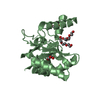

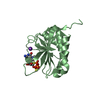
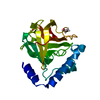
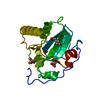

 PDBj
PDBj
